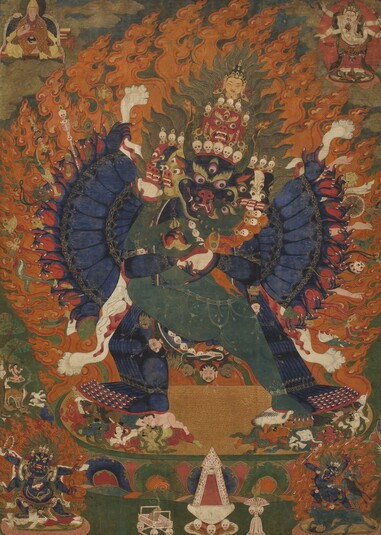
Item: Vajrabhairava (Buddhist Deity) - with consort
| Origin Location | Tibet |
|---|---|
| Date Range | 1700 - 1799 |
| Lineages | Gelug and Buddhist |
| Material | Ground Mineral Pigment on Cotton |
| Collection | Private |
Classification: Deity
Appearance: Animal-Feature
Gender: Male
Vajrabhairava (Tibetan: dor je jig je. English: Vajra Terror) with the consort Vajra Vetali.
Vajrabhairava, in the center, is terrifying and wrathful, dark blue in colour with nine faces, thirty-four arms and sixteen legs. The main face is that of a buffalo, with a red face above and the slightly angry yellow face of Manjushri placed on top. The three right faces are yellow, dark blue and red and the three left are black, white and smoky. Each face has three large round eyes, bared white fangs and frightful expressions; dark yellow hair flows upward; adorned with bone ornaments and a necklace of fifty heads. The first pair of hands hold a curved knife and skullcup embracing the consort. The remaining hands hold a variety of objects. The consort Vajra Vetali has one face and two hands, blue in colour with orange hair pressed against the back; holding a skullcup in the left hand. The right legs of Vajrabhairava are bent pressing down on various animals and gods. The left legs are extended straight and press upon various birds and gods; standing above an orange sun disc and multi-coloured lotus completely surrounded by the orange flames of pristine awareness.
At the upper left side is the 8th Dalai Lama Jampal Gyatso (1758-1804). At the upper right is White Shadbhuja Mahakala. At the lower left is Shadbhuja Mahakala. On the right side is Yama Dharmaraja with Chamundi, both standing atop a buffalo. At the bottom center is a red triangular offering of stylized food (torma) atop a skull bowl.
As a meditational deity Vajrabhairava, also known as Yamantaka, belongs to the Yamari class of tantras and specifically arises from the Bhairava Root Tantra (Tibetan: Jig je tsa gyu) and is classified as method (father) Anuttaryoga Tantra. The practice of Vajrabhairava is common to the three Sarma Schools: Sakya, Kagyu and Gelug. There are numerous forms and styles of practice from the very complex with numerous deities to the very concise with a single Heruka form. The main lineages to enter Tibet were those of Jowo Atisha, Rwa Lotsawa, Mal Lotsawa and others.
Jeff Watt 7-2014
Collection: Bonhams (Painting & Sculpture. Fall, 2014)
Buddhist Deity: Vajrabhairava (Best Examples, Painting)
Buddhist Deity: Vajrabhairava Main Page



